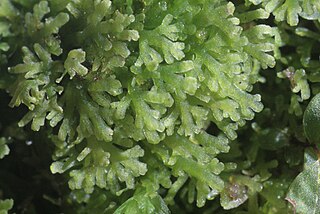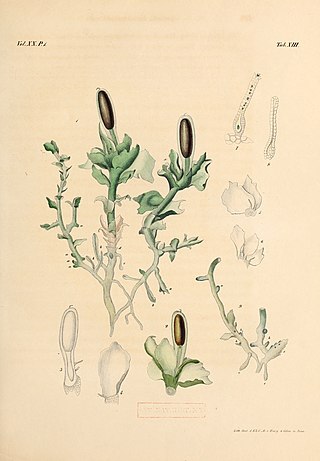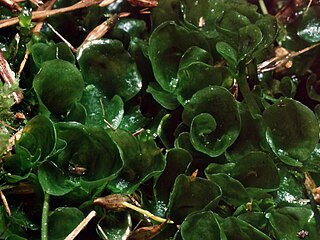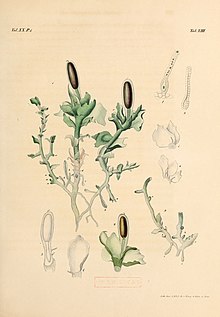
The Marchantiophyta are a division of non-vascular land plants commonly referred to as hepatics or liverworts. Like mosses and hornworts, they have a gametophyte-dominant life cycle, in which cells of the plant carry only a single set of genetic information.

Marchantiales is an order of thallose liverworts that includes species like Marchantia polymorpha, a widespread plant often found beside rivers, and Lunularia cruciata, a common and often troublesome weed in moist, temperate gardens and greenhouses.

Marchantiopsida is a class of liverworts within the phylum Marchantiophyta. The species in this class are known as complex thalloid liverworts. The species in this class are widely distributed and can be found worldwide. Complex oil bodies are only found in the gametophyte.

Lunularia is a genus of liverworts whose only species is Lunularia cruciata, the crescent-cup liverwort. Lunularia is either the only genus in the order Lunulariales, or may be placed in the order Marchantiales. The name, from Latin luna, moon, refers to the moon-shaped gemma cups.

Jungermanniales is the largest order of liverworts. They are distinctive among the liverworts for having thin leaf-like flaps on either side of the stem. Most other liverworts are thalloid, with no leaves. Due to their dorsiventral organization and scale-like, overlapping leaves, the Jungermanniales are sometimes called "scale-mosses".

Metzgeriales is an order of liverworts. The group is sometimes called the simple thalloid liverworts: "thalloid" because the members lack structures resembling stems or leaves, and "simple" because their tissues are thin and relatively undifferentiated. All species in the order have a small gametophyte stage and a smaller, relatively short-lived, spore-bearing stage. Although these plants are almost entirely restricted to regions with high humidity or readily available moisture, the group as a whole is widely distributed, and occurs on every continent except Antarctica.

Sphaerocarpales is an order of plants within the liverworts. Approximately twenty species are in this order which is sub-divided into four families: Monocarpaceae, Sphaerocarpaceae and Riellaceae, as well as the extinct family Naiaditaceae. The inclusion of the Naiaditaceae is uncertain, and the family has sometimes been assigned to the Calobryales.

Jungermanniopsida is the largest of three classes within the division Marchantiophyta (liverworts).

Haplomitriopsida is a newly recognized class of liverworts comprising fifteen species in three genera. Recent cladistic analyses of nuclear, mitochondrial, and plastid gene sequences place this monophyletic group as the basal sister group to all other liverworts. The group thus provides a unique insight into the early evolution of liverworts in particular and of land plants in general.
Gessella is a fossil genus of liverworts in the family Haplomitriaceae. All known fossils come from Early Permian deposits of Western Sealand.

Aytoniaceae is a family of liverworts in the order Marchantiales.

Pleurozia is the only genus of liverworts in the family Pleuroziaceae, which is now classified in its own order Pleuroziales, but was previously included in a broader circumscription of the Jungermanniales. The genus includes twelve species, and as a whole is both physically distinctive and widely distributed.
Pseudolepicoleaceae is a family of liverworts in the order Jungermanniales.

Cephaloziaceae is a family of liverworts.

Haplomitrium is a genus of liverworts.
Haplomitrium hookeri, or Hooker's flapwort, is a species of liverwort. It occurs in Europe, Asia, North America and New Zealand.

William Campbell Steere (1907–1989) was an American botanist known as an expert on bryophytes, especially arctic and tropical American species. The standard author abbreviation Steere is used to indicate this person as the author when citing a botanical name.

Neohodgsonia is a genus of liverworts containing the single species Neohodgsonia mirabilis. Neohodgsonia is the only genus in the family Neohodgsoniaceae, which is the only family in the order Neohodgsoniales.

Pelliales is an order of liverworts.

Pallaviciniales is an order of liverworts.
















